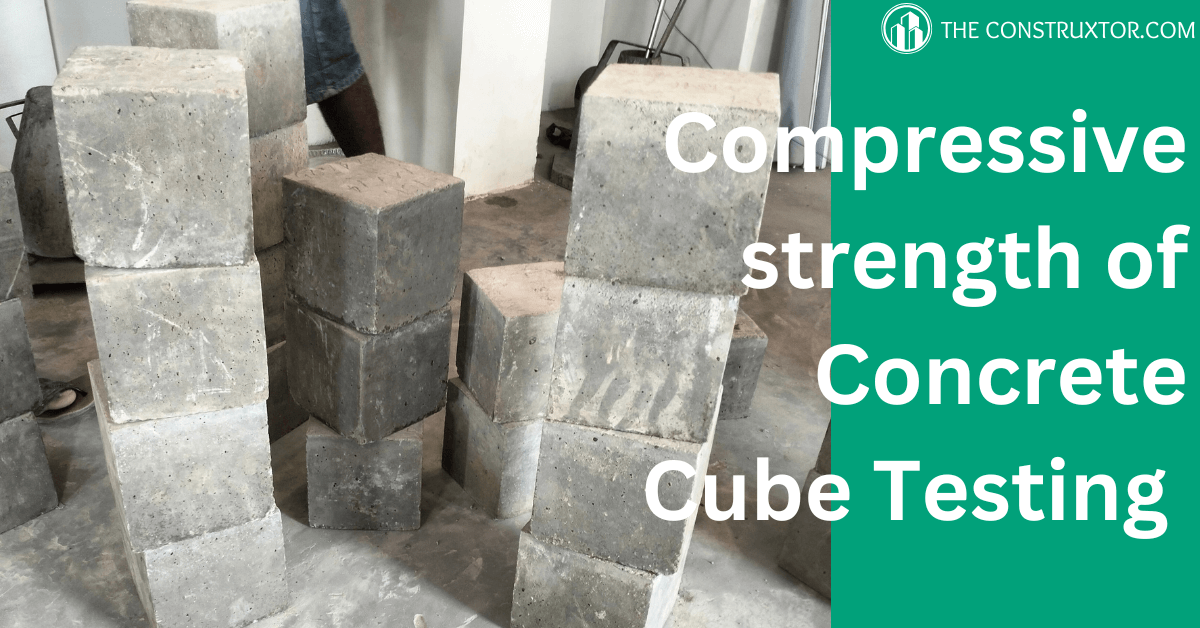Concrete is a fundamental material in construction, and as a civil or site engineer, it is your responsibility to ensure that the concrete delivered to your site is suitable for casting. To check quality of concrete we do compressive strength of concrete cube test. You must also verify whether it achieves the required strength as per the design specifications and within the expected time frame.
Hello readers, welcome to my blog! Here, we share practical knowledge related to civil engineering that you can truly benefit from. Thank you for visiting — I hope you find the content valuable. In today’s blog, we will discuss the importance of concrete cube testing, covering the entire process from start to finish.
Testing of Compressive Strength of Concrete Cube.

The Slump Test of Concrete for workability of concrete : A practical Procedures.
Why do we use PCC (plain cement concrete) in construction? 7 tips to know.
How to calculate the concrete quantity for the footing?
Whenever we need to assess the compressive strength of concrete, the most common method is to test concrete cubes. These tests are performed using a CTM (Compression Testing Machine) to determine whether the concrete used in construction meets the required strength standards.
Reference Standard: IS 456:2000 for concrete cube test :
The acceptance criteria for concrete compressive strength are specified in IS 456:2000, which guides the process of sampling, testing, and evaluating the quality of concrete.
Materials and Equipment Required
To perform the concrete cube test properly, the following tools and materials are required:
- Cube Molds (Size: 150 mm × 150 mm × 150 mm)
- Tamping Rod (16 mm diameter, 600 mm long)
- Concrete Scoop
- Steel Trowel / Finishing Plate
- Weighing Scale
- CTM (Compressive Testing Machine)
- Curing Tank / Water Tank
- Oil or Lubricant (for mold surface)
- Measuring Tape / Marker (for labeling)
Sampling Criteria for Concrete Cube Test :
According to IS 456:2000, the number of concrete cube samples to be tested depends on the volume of concrete placed:
| Concrete Volume | Number of Samples (Set of 3 Cubes) |
|---|---|
| 1 – 5 m³ | 1 Sample |
| 6 – 15 m³ | 2 Samples |
| 16 – 30 m³ | 3 Samples |
| 31 – 50 m³ | 4 Samples |
| > 50 m³ | 4 Samples + 1 Sample for every additional 50 m³ |
Note: One sample = average of 3 cubes.
Cube Casting Procedure :

The casting of cube is critical for accurate test results. It is important to follow the steps carefully as per IS code, Here’s a step-by-step guide:
- Preparation of Molds:
- First place the cube molds on a flat, level, and clean surface,
- Apply a thin layer of oil on the inner surfaces to prevent concrete from sticking, so it can be opened easily.
- Filling the Molds:
- The concrete is taken in the plate and than it should be mixed thoroughly and fill it in the mold.
- Fill the mold in three layers.
- Each layer is tempted for 35 times with temping rod, it can release the entrapped air and compact very well.
- Finishing the Surface:
- Once we filled the cube, the top surface is leveled with finishing plate.
- Let concrete cube settled for sometime so we can write an important details such as date, grade of concrete (e.g., M20, M25), and any other identification on the cube.
Curing of Cubes
- After 24 hours, remove the concrete cubes from the molds carefully.
- Immerse the cubes in a curing tank or water bath, ensuring full submersion at a controlled temperature (ideally 27 ± 2°C).
- Keep the cubes under curing conditions until the day of testing (7 or 28 days).
Testing Procedure of Concrete Cubes
Concrete cube strength is commonly tested at 7 days and 28 days. Here’s how the process goes:
1. Preparation Before Testing:
- Remove the cube from the curing tank.
- Wipe off any excess water and surface moisture.
- Weigh the cube using a weighing scale. The weight should be approximately 8.1 kg for a 150 mm cube. A significant reduction may indicate internal voids.

2. Testing in CTM Machine:
- Place the cube in the CTM machine centrally.
- Apply the load gradually at the rate of 140 kg/cm² per minute (as per IS 516) until the cube fails.
- Record the maximum load at failure in kN (kilonewtons).
3. Calculating Compressive Strength:
Compressive Strength (MPa) = Maximum Load (N) / Area of Cube Face (mm²)
Compressive Strength (MPa) = Maximum Load (N) / Area of Cube Face (mm²)
Area=150 mm×150 mm=22500 mm²
- Calculate the compressive strength for all 3 cubes.
- Take the average of the three results to get the final compressive strength for that sample.
Strength Requirements as per IS Code
Concrete should achieve the following minimum strengths:
| Age of Cube | Target Strength (Percentage of 28-day Strength) |
|---|---|
| 7 Days | 70% |
| 14 Days | 87.5% |
| 28 Days | 100% |
In practice, concrete may gain up to 99–100% strength by 28 days. However, if conditions are unfavorable or there are issues in mixing or curing, strength gain may be delayed. Concrete can continue to gain strength up to 365 days under proper curing.
What If the Strength is Lower Than Required?
If the compressive strength is significantly lower than required:
- Perform core cutting tests or non-destructive tests (like rebound hammer or ultrasonic pulse velocity) on actual structural elements.
- Evaluate whether the structure can still be accepted or if any strengthening measures are needed.
- Further decisions are taken based on IS 456:2000 and guidance from a structural engineer.
✅ Conclusion
Compressive strength testing of concrete cubes is a fundamental quality check in any construction project. By following standard procedures, using proper tools, and adhering to IS codes, we can ensure that the concrete used is reliable and capable of sustaining the designed loads safely.
Follow us :- Pinterest Facebook
Also read,
What is a role of a PMC civil engineer in construction?
Why You Should Visit an RMC Plant & Key Considerations for Concrete Sample and Testing.
Comprehensive Guide to the Types of Foundations in Construction.












Good write-up, I¦m normal visitor of one¦s blog, maintain up the excellent operate, and It is going to be a regular visitor for a long time.